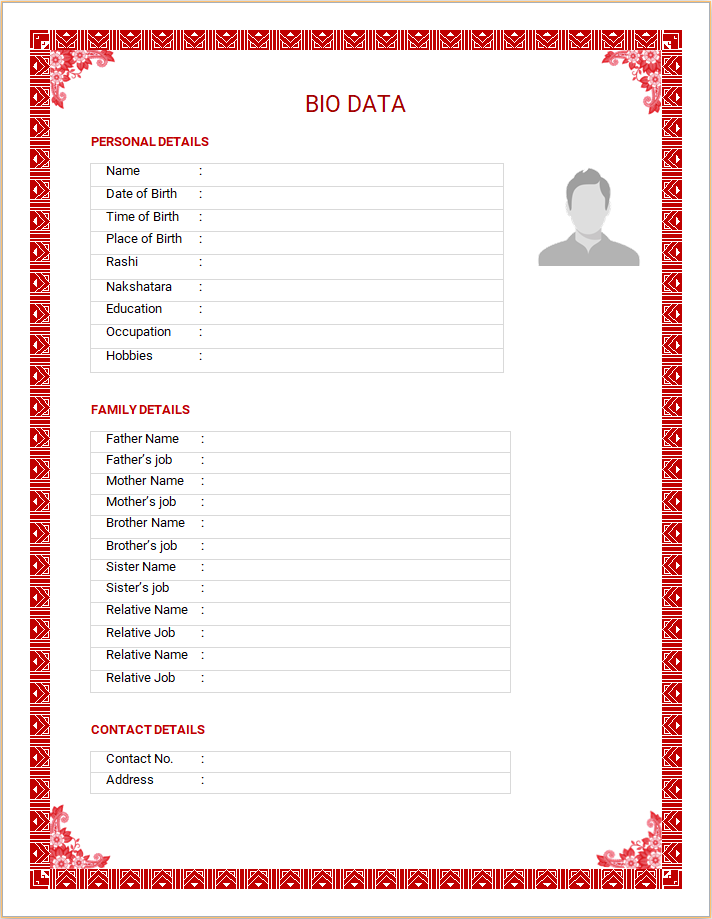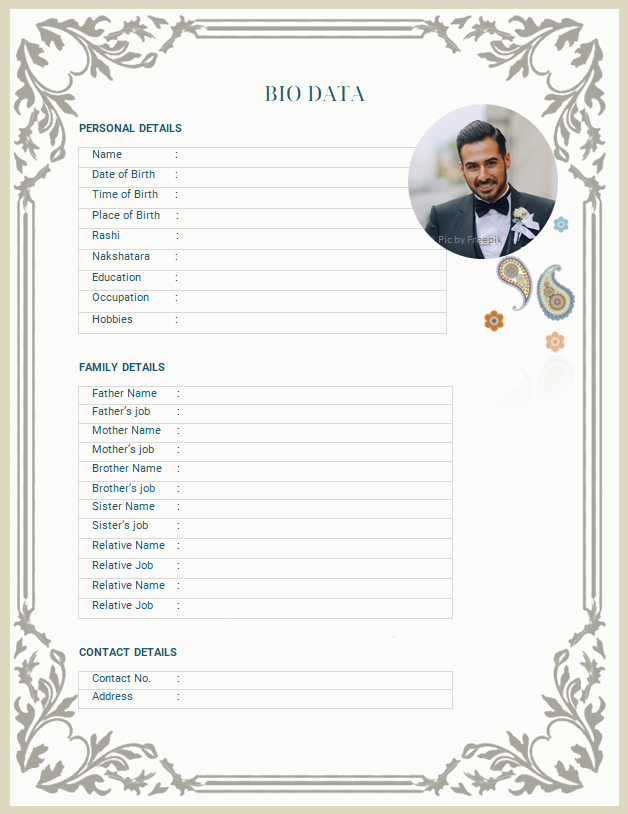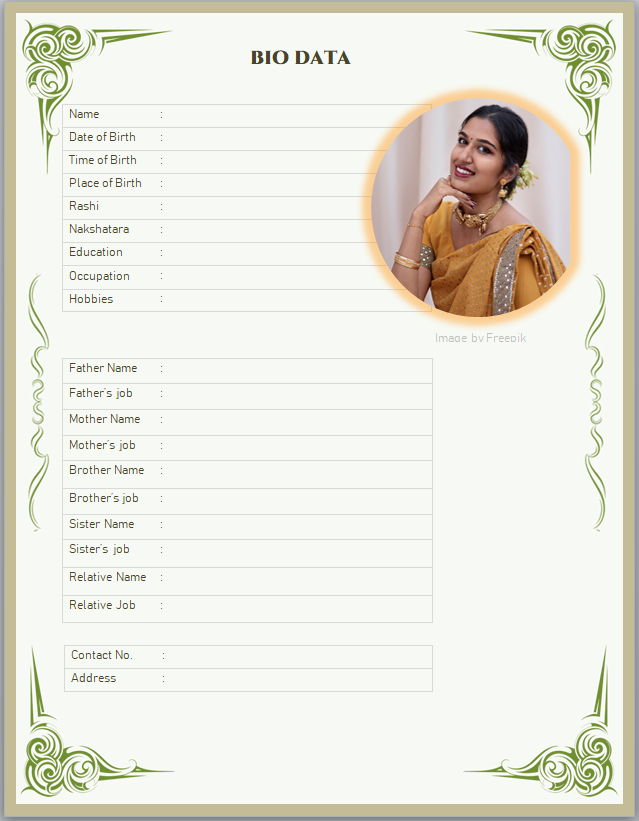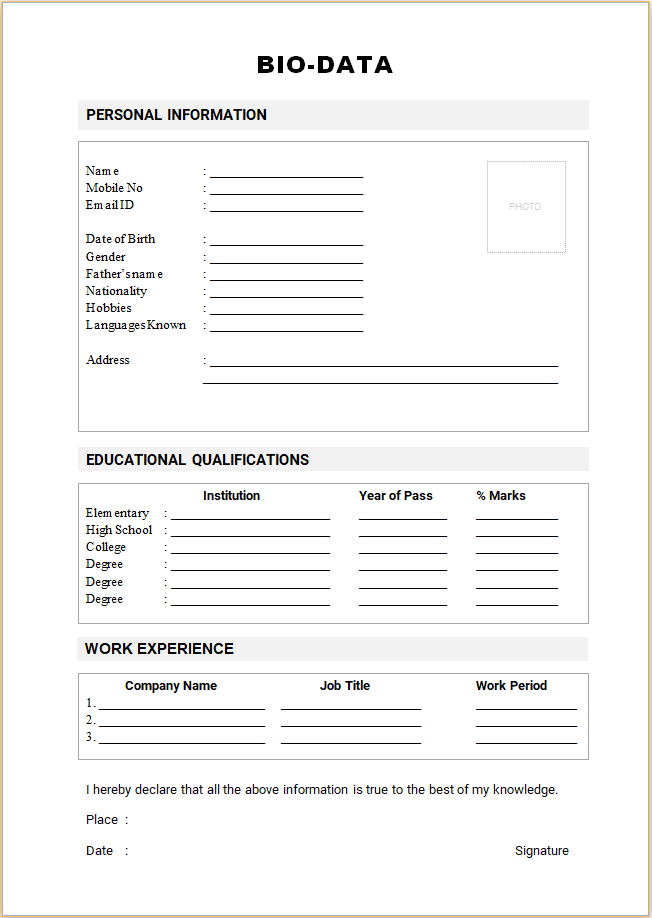Marriage Biodata Format
Matrimonial biodata format

Biodata format
When preparing a biodata for matrimonial purposes, it's essential to provide relevant and meaningful information about yourself. Here's a guide on what to include and what to exclude:
What to Include:
Personal Information:
Full Name
Date of Birth
Place of Birth
Time of Birth (if relevant in your culture)
Contact Details:
Address
Phone Number
Email Address
Educational Background:
Academic qualifications (degrees, institutions, years)
Any additional certifications or relevant training
Professional Details:
Current Occupation
Employer's Name
Job Title
Work Location
Family Background:
Parents' names and occupations
Siblings' details (names and occupations)
Physical Attributes:
Height
Weight
Complexion
Hobbies and Interests:
Personal interests and hobbies
Activities you enjoy in your free time
Values and Beliefs:
Mention any important values or beliefs that are significant to you.
Astrological Information:
If astrological details are culturally important, include them (e.g., horoscope details).
Social and Community Involvement:
Any community or social service involvement
Expectations:
Clearly state what you are looking for in a partner, such as values, personality traits, or any specific expectations.
Photographs:
Include recent and clear photographs of yourself.
What to Exclude:
Irrelevant Personal Details:
Exclude unnecessary personal information such as passport numbers, Aadhar card details, etc.
Excessive Details:
Keep it concise. Avoid including too many details; focus on the most important and relevant information.
Negative Information:
Avoid discussing negative experiences or personal conflicts.
Financial Details:
Keep financial details private and discuss them at an appropriate time.
Overemphasis on Material Possessions:
While it's okay to mention your occupation, avoid bragging about material possessions.
Unverified Claims:
Be honest and avoid making unverified claims or exaggerations.
Too Formal or Too Casual Language:
Maintain a balance in your language. Be respectful but not overly formal or too casual.
Inappropriate Jokes or Language:
Avoid using inappropriate jokes or language that might be offensive.
Unrealistic Expectations:
Be realistic in your expectations and avoid creating a checklist that is too specific.
Incomplete Information:
Ensure all relevant information is included to provide a comprehensive view of yourself.
Remember, the purpose of a matrimonial biodata is to give a sincere and accurate representation of yourself. Tailor it to your cultural and personal context while being respectful and considerate.
Additional Inputs
What format to use for your marriage biodata
Choosing the best file format for a marriage biodata is crucial to ensure compatibility, readability, and ease of sharing. Here are some considerations and advice on file formats:
1. PDF (Portable Document Format):
Considerations: PDF is one of the most widely accepted and stable file formats. It preserves the document's layout, fonts, and formatting across different devices and operating systems. PDFs are easy to share and can be viewed using free PDF reader software available on various platforms.
Advice: Save your marriage biodata as a PDF to maintain a consistent and professional appearance. This format is particularly suitable when sharing the document via email or through online platforms. It ensures that the recipient sees the biodata exactly as you intended, minimizing the risk of formatting issues.
2. Word Document (DOC or DOCX):
Considerations: Microsoft Word documents, in DOC or DOCX format, offer flexibility for editing and customization. They are commonly used for creating and sharing documents. However, there is a risk of formatting discrepancies when opening the document on different devices or using different versions of word processing software.
Advice: If you anticipate that the recipient may need to make edits to the biodata, a Word document can be a suitable choice. However, be aware that the formatting may need adjustment based on the software and settings used by the recipient.
3. Image File (JPEG or PNG):
Considerations: Converting your biodata into an image file, such as JPEG or PNG, can be an option if you want to ensure the document's visual integrity. However, keep in mind that text in an image is not searchable or editable, and the file size might be larger compared to a PDF or Word document.
Advice: Use image files sparingly, and only if necessary. While they maintain visual consistency, they may pose challenges for recipients who want to extract text or make modifications. Reserve image formats for situations where visual aesthetics are a top priority, such as when including a scanned signature or handwritten details.
In summary, choosing the right file format for your marriage biodata depends on your specific needs and the preferences of the recipient. PDFs are generally recommended for their universality and stability, ensuring that your biodata looks consistent and professional across various platforms. If flexibility for editing is crucial, a Word document might be suitable, but be mindful of potential formatting variations. Image files can be used selectively for visual impact but may limit functionality for the recipient.


